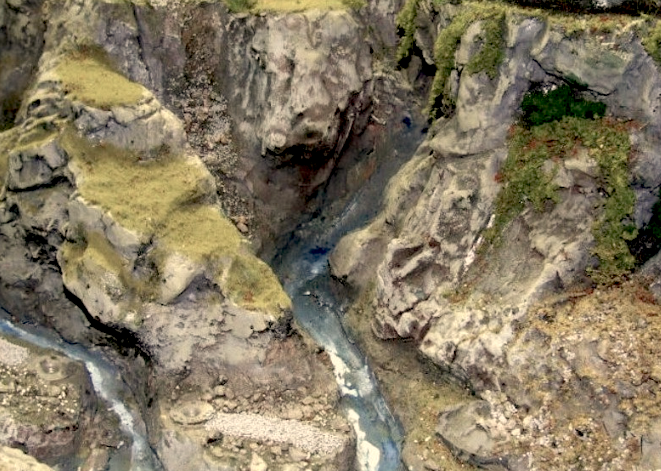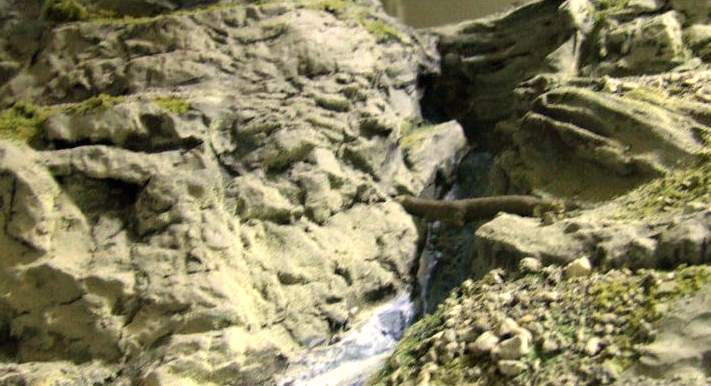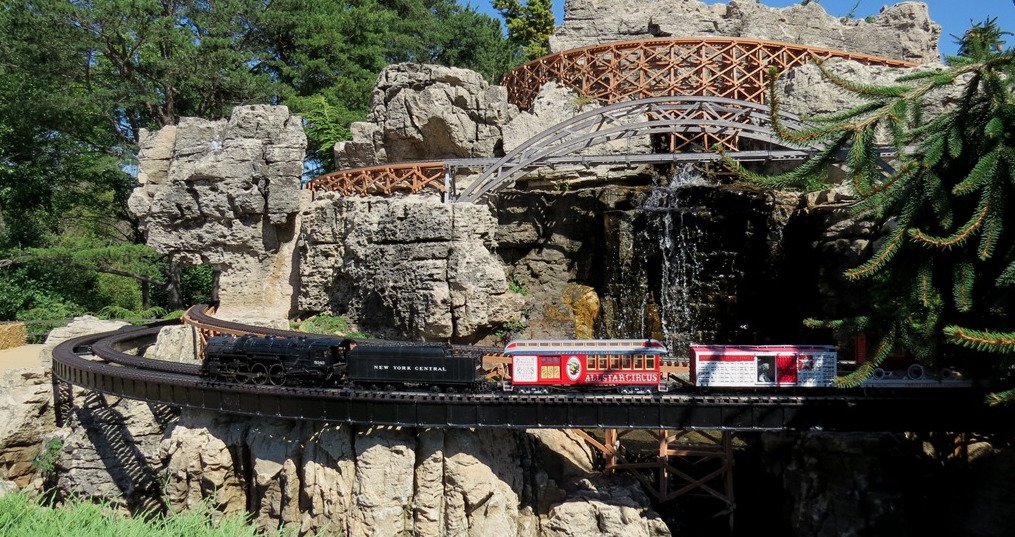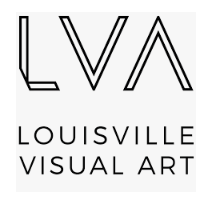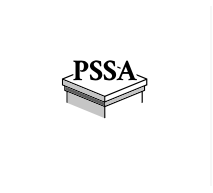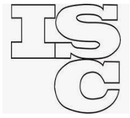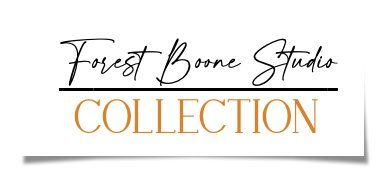
Bronze & Stone Artwork
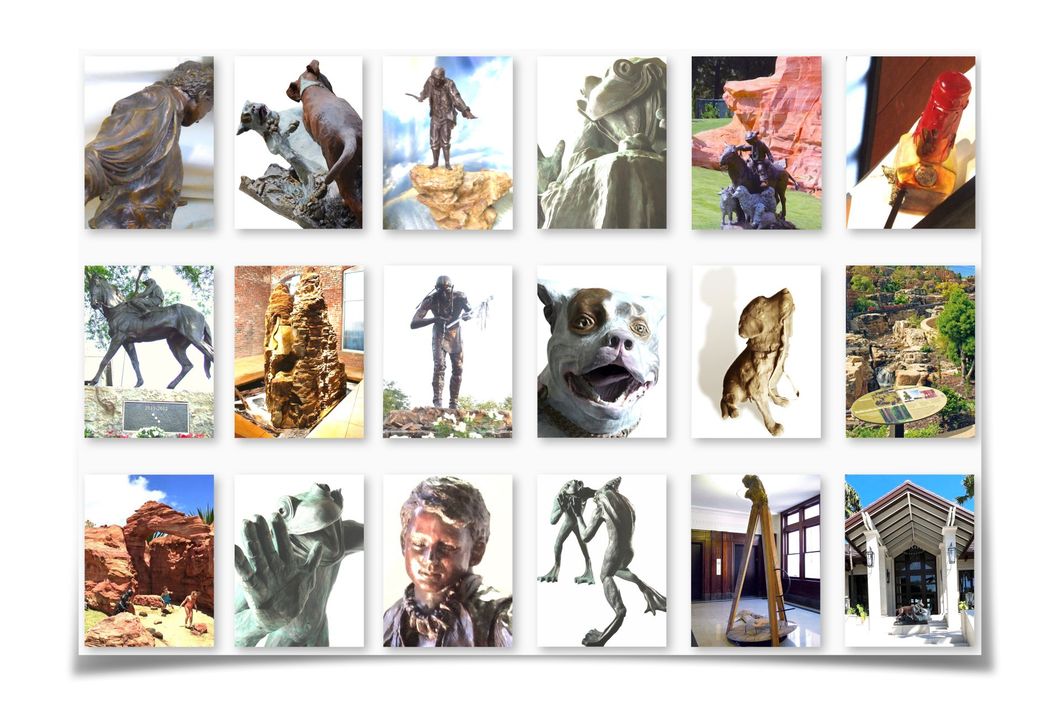
Leap of Faith Bronze Statue
We had the privilege of sculpting this statue for the lobby of a corporate headquarters. Since we have now created several different versions of it, including tabletop versions, this is a good bronze statue to use as an example, as it best illustrates the following: The attention we give to fine details; the research and development that goes into our sculptures; and the gestural studies, with a live model, which always strengthens the concept. All of these things add to the power of the piece. Many sculptors can make pretty art. It's true. But what about the concept-the deeper meaning that makes the work of art timeless and much more than something that is pretty to look at? Well, that is our strength! The conceptual basis for our Leap of Faith statue below, for example, is deeply rooted in rich Kentucky history, tradition, and most importantly, spirituality.
In other words, there is much more to this sculpture (like all of our bronze statues) than meets the eye.
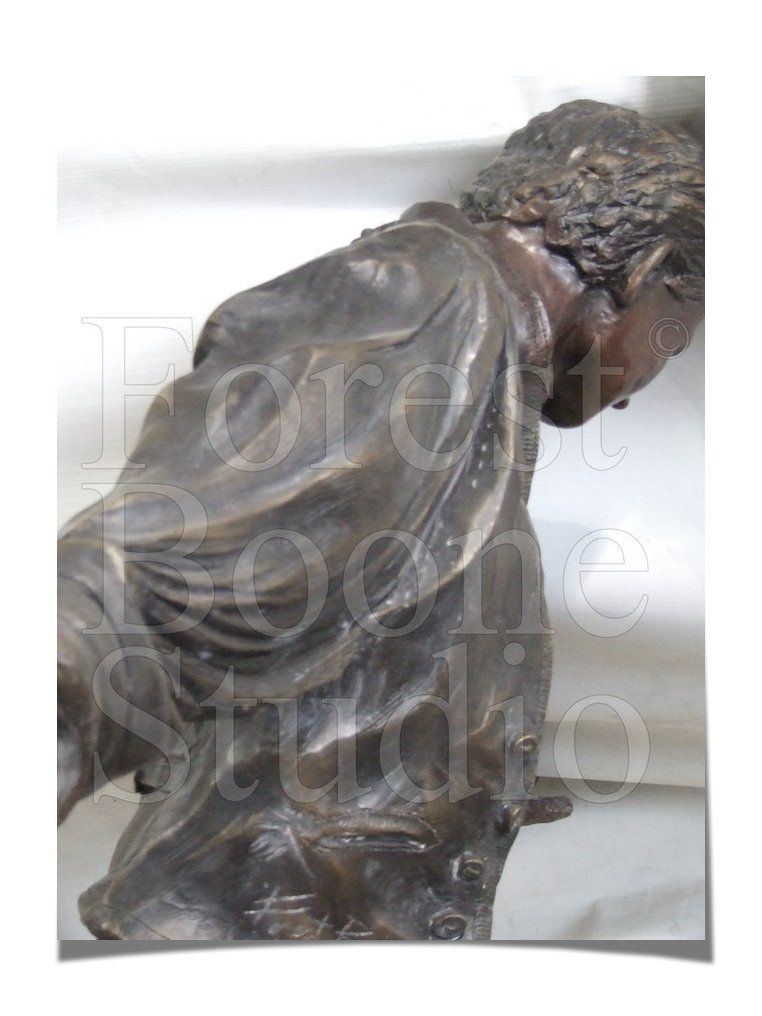
Shown here, is Leap of Faith, installed in the corporate headquarters, after the building was rededicating, based on the actual sculpture and a Shark-Tank-like, master incentive program, complete with our hand sculpted cliff-like monolith and cloud backdrop, both of which provide the context.
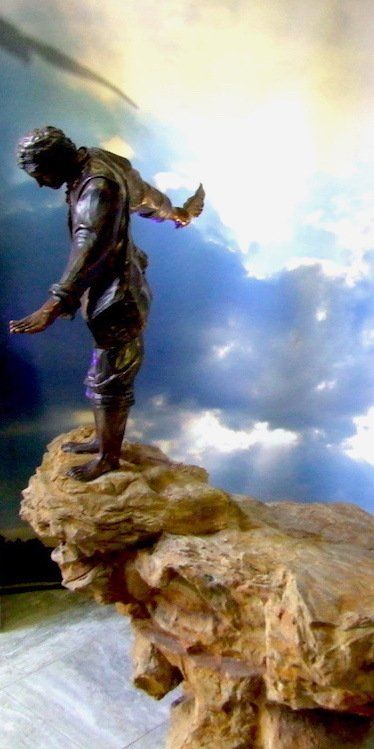
Below: Leap of Faith image, without the distraction of color to help you see the sculpted form, in high fidelity detail.
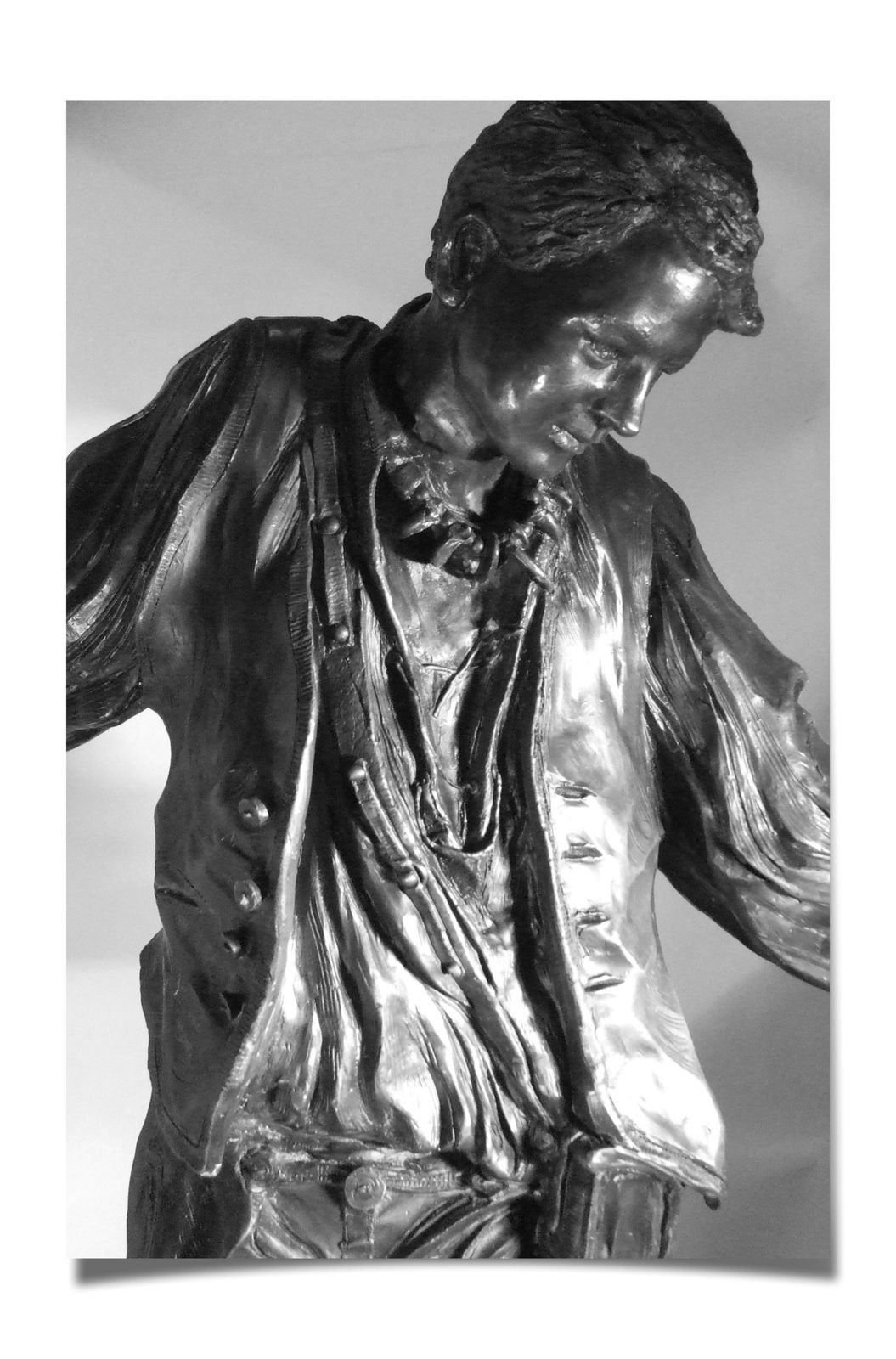
Next shown is the original Forest Boone clay sculpture before being cast in bronze. The importance of what we are showing you here is the photocopy-like exactness between the clay and the bronze. Just take a moment by viewing in the images above and below to see for yourself.
What this means for you as a client is that the sculpture you commission you can physically come to our studio to approve the piece in person while it is still sculpted in clay. And that clay always turns out exactly like the final statue after being cast in bronze. In other words, if there is an element of your sculpture that you are not altogether happy with at first, or something that you feel can stand a little evolutionary improvement, we gladly tweak the original clay sculpture so that you feel great about how it looks before it goes to our bronze casting foundry. That means zero risk of mistakes and it guarantees your satisfaction!
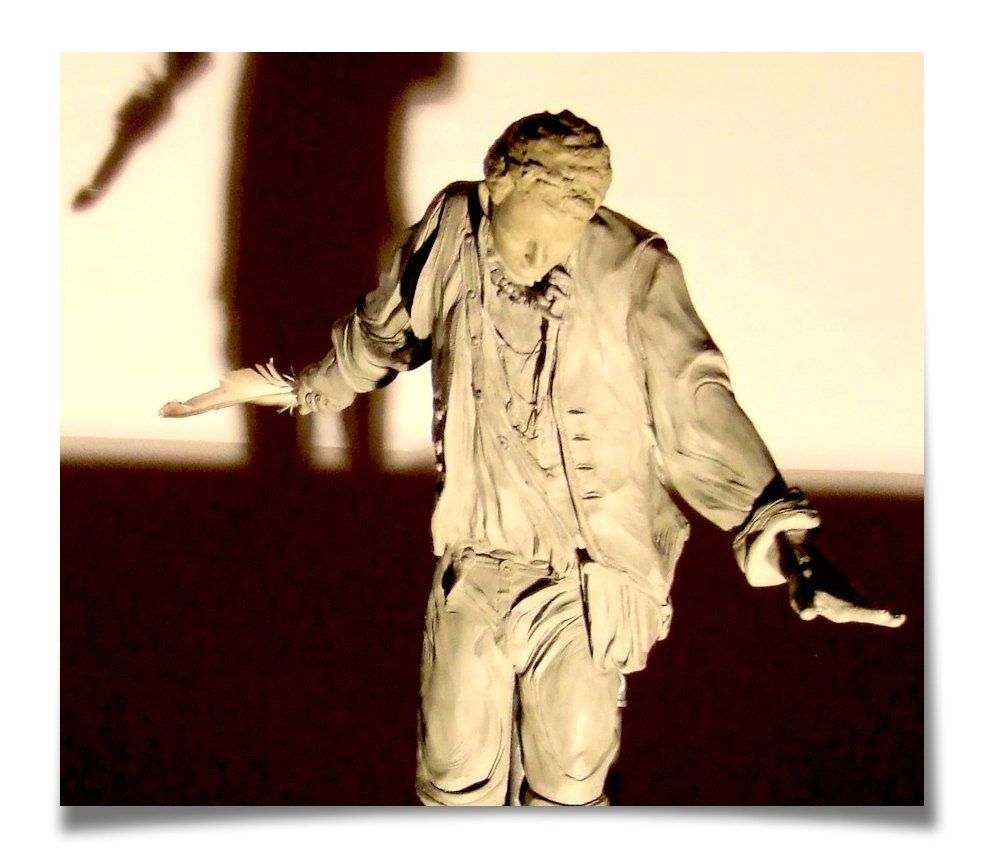
Leap of Faith, rear view, below. Note the feather in the boy's hand. This feather metaphorically represents his faith, which is the very thing that will allow him to take the leap of faith, jump, and be okay.
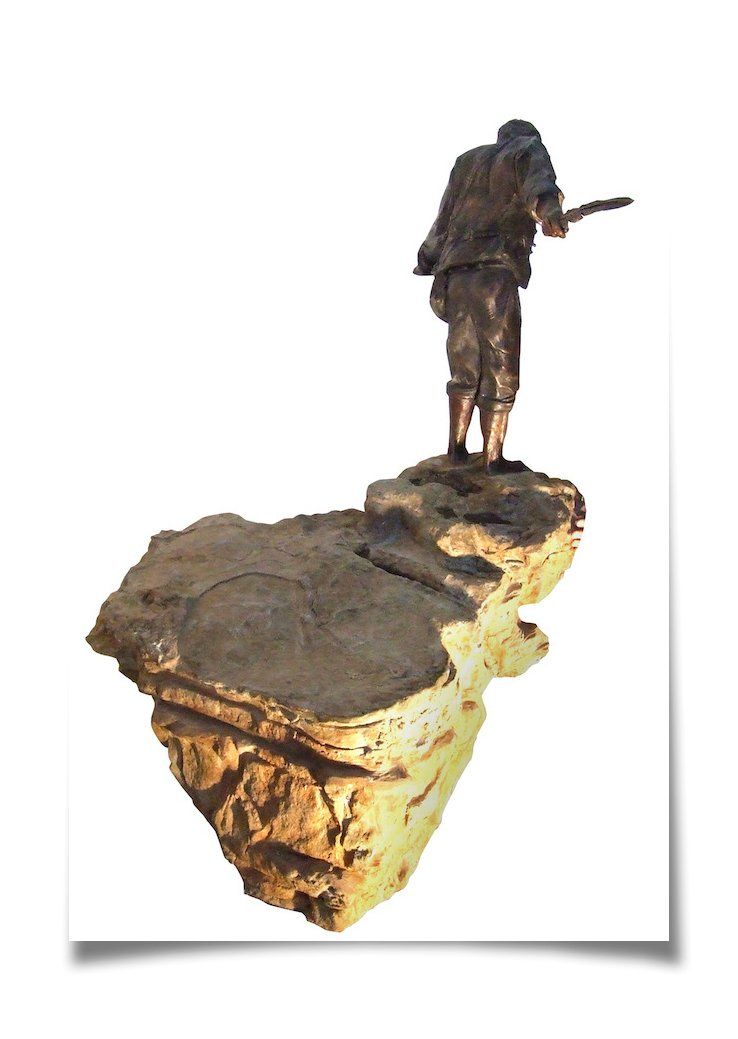
New Paragraph
As you view the works on this page, we encourage you to pay close attention to all of the extra detail, such as this bear claw necklace, because most sculptor's websites only show images of their bronze sculptures from a distance. Is it not true, that you, the client, want your sculpture to physically be viewed up close and personal? It is for this reason that we go through the trouble and spend countless hours to ensure that every single detail is painstakingly sculpted into the piece.
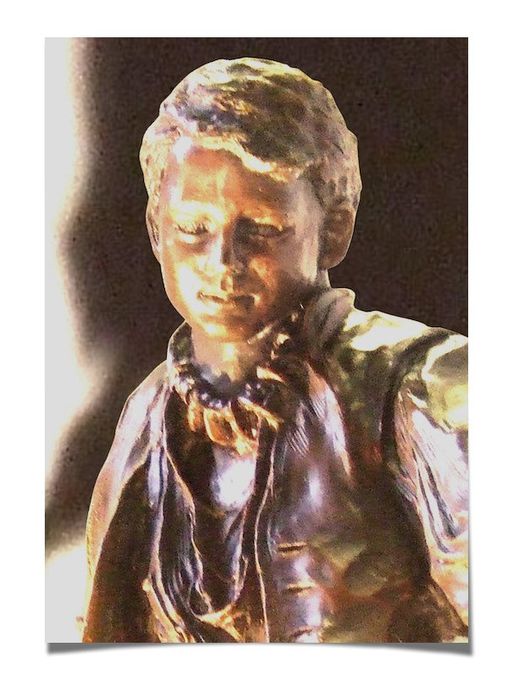
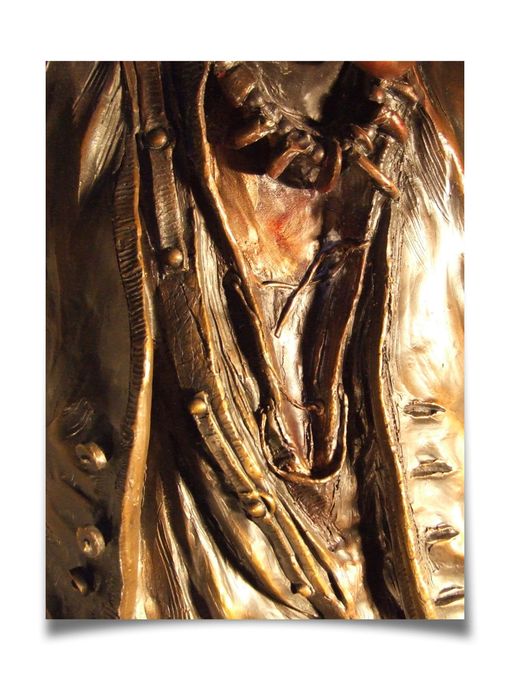
With that said, take a look at the strings, buttons, and even the cracked leather of the thongs here in the image to the below.
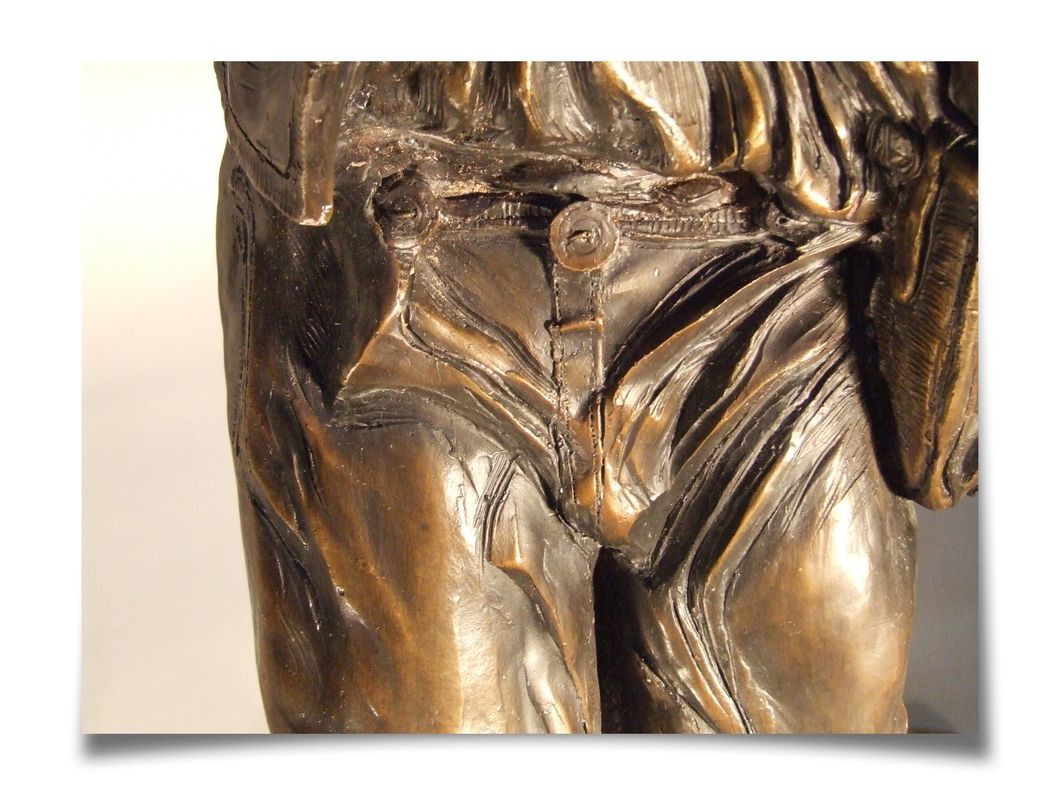
Leap of Faith, front of "britches" and saddlebag, above.
Below, take note of not only the detailed feather but also feel the tension of the vest strap as you see it "pulling."
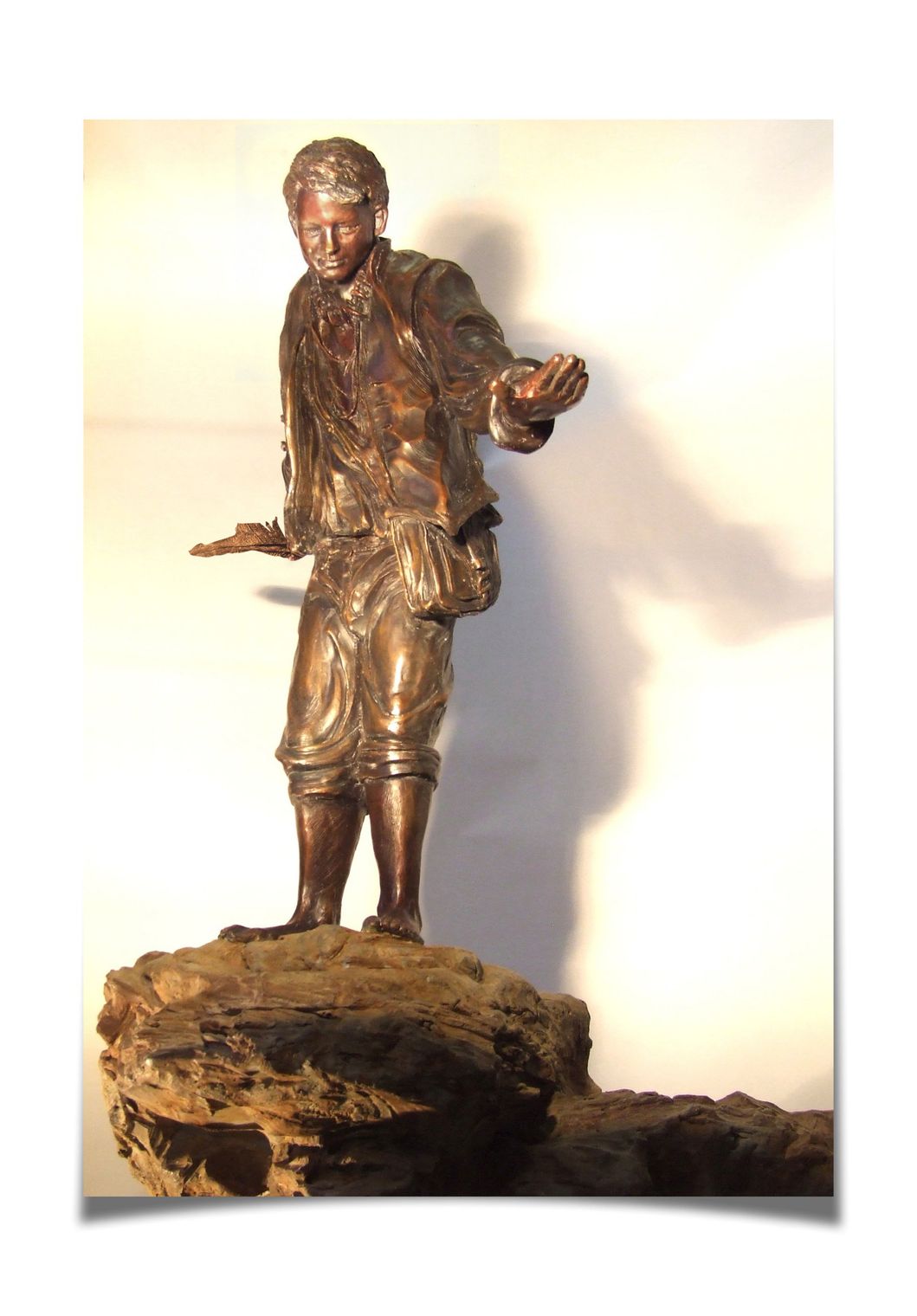
Again, note the sharp, vivid detail. You ae actually looking at two sculptures here-the bronze statue and the sculpted rock cliff.
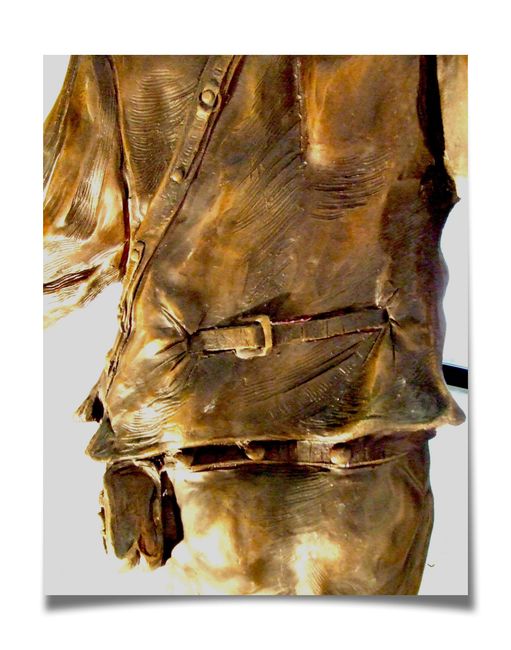
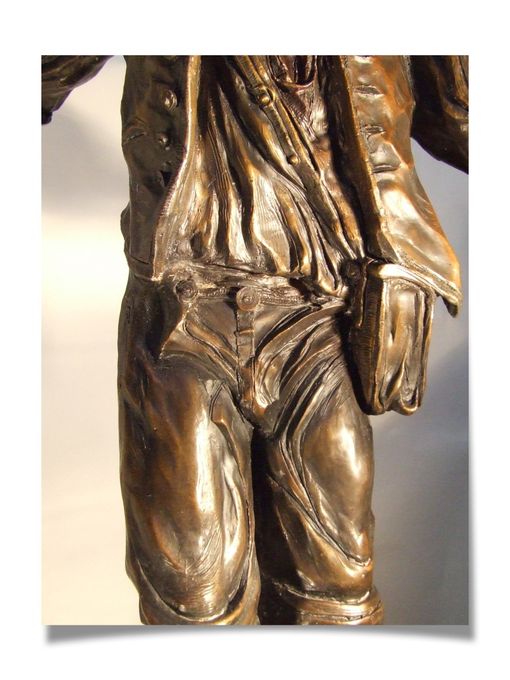
Last but not least, extra tension and a sense of excitement is created by having the boy's feet situated on the very edge of the cliff. The viewer gets a real sense of the boy being ready to jump-to take a leap of faith.
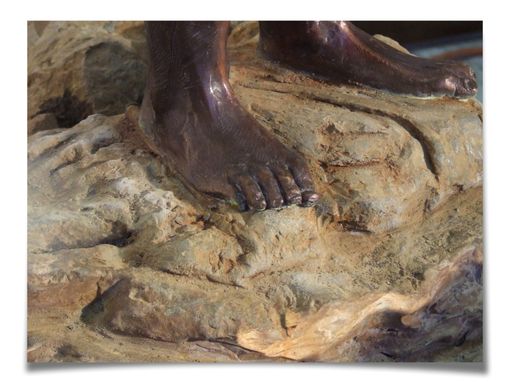

Bronze Statues of Animals & Memorial Sculptures by Forest Boone Studio
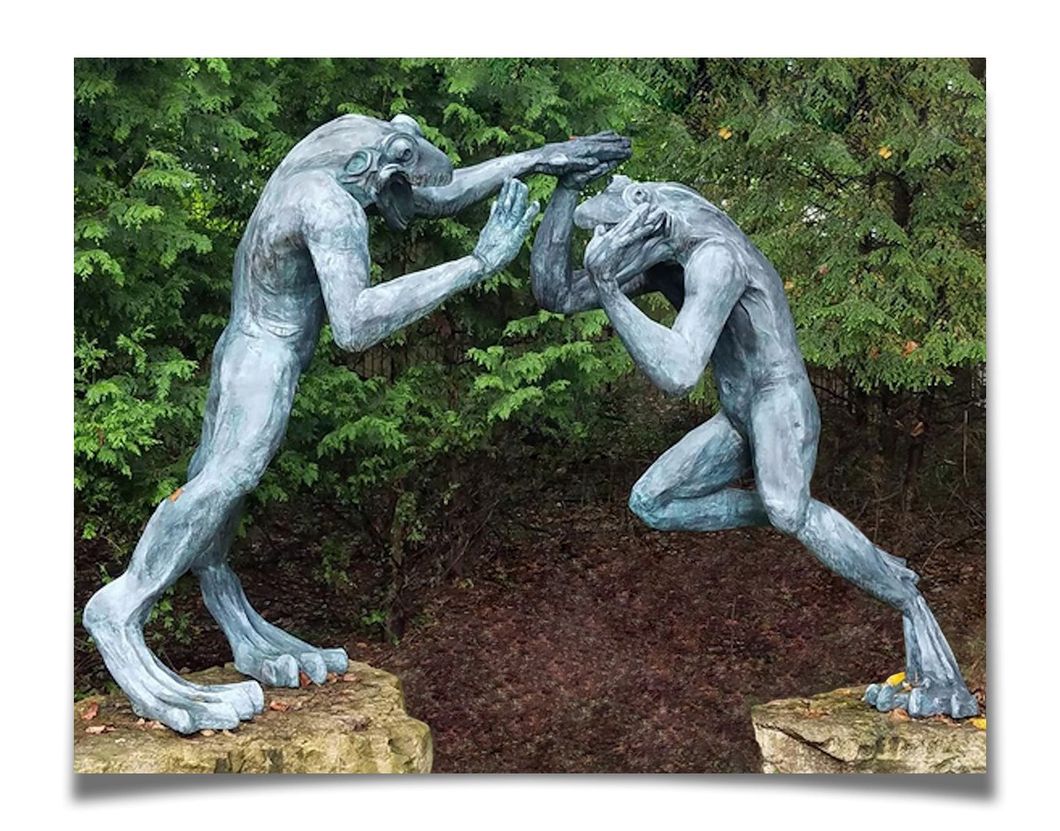
Above is a series of photos showing our larger-than-life, seven foot tall, Happy Frogs. The top image shows this sculpture installed on site. Forest Boone sculpted these anthropomorphic bronzes for the estate of former Yum! Brands CEO, David Novak.
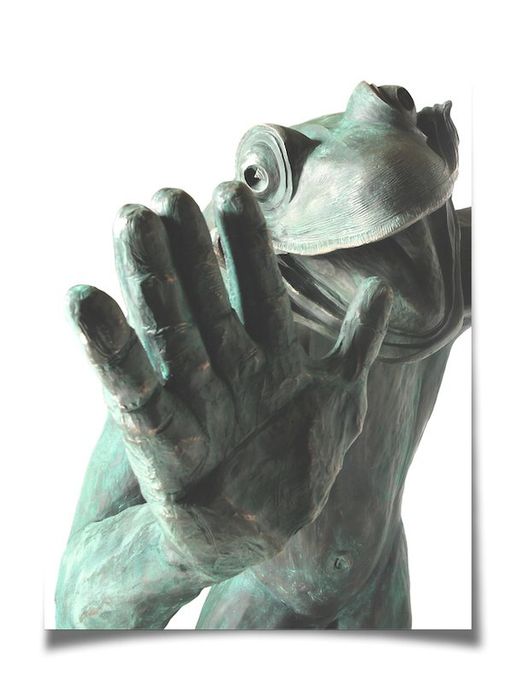
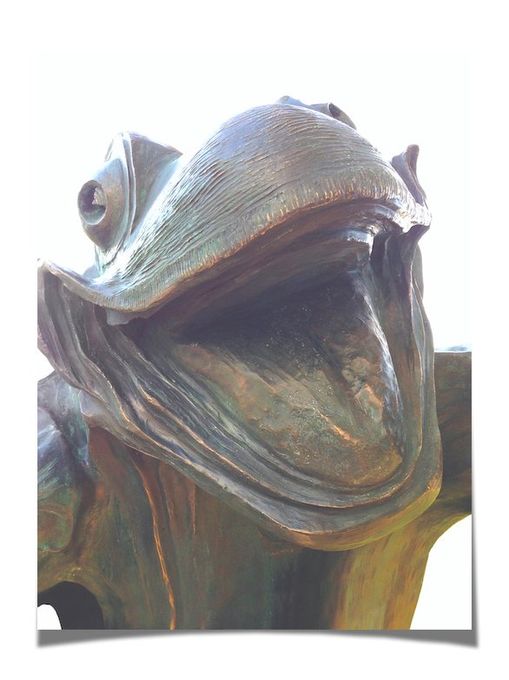
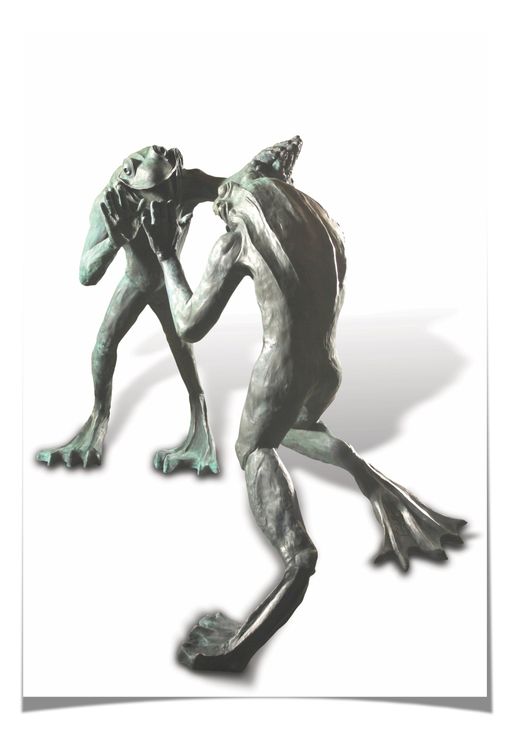
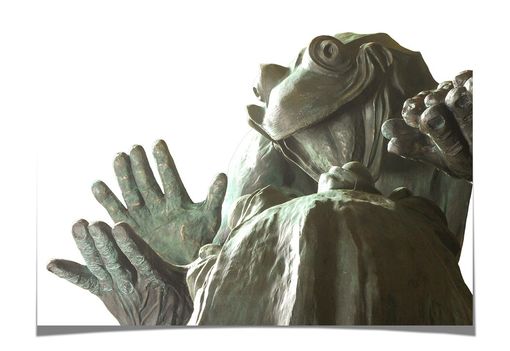
Below, another bronze statue mounted upon a rock-like base, this time a race horse memorial. Note the congruence: a horse is from the animal kingdom, and the animal kingdom is where natural rock is found. ...Not rectangular granite, not squared off limestone, but more geological ("live edge" if you will), as it is found in nature, which is conceptually parallel to horses which are found in the animal kingdom. Make sense?
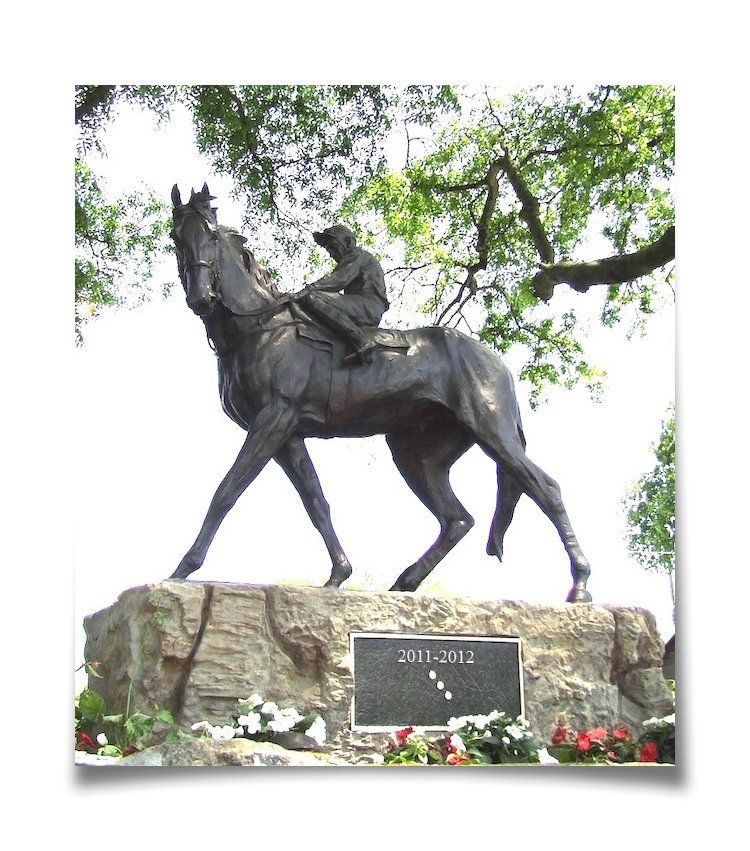
The following sculpture is a memorial for Cave Hill Cemetery. In this case, a dog memorial (Labrador Retriever) for a beloved family dog named Remi.
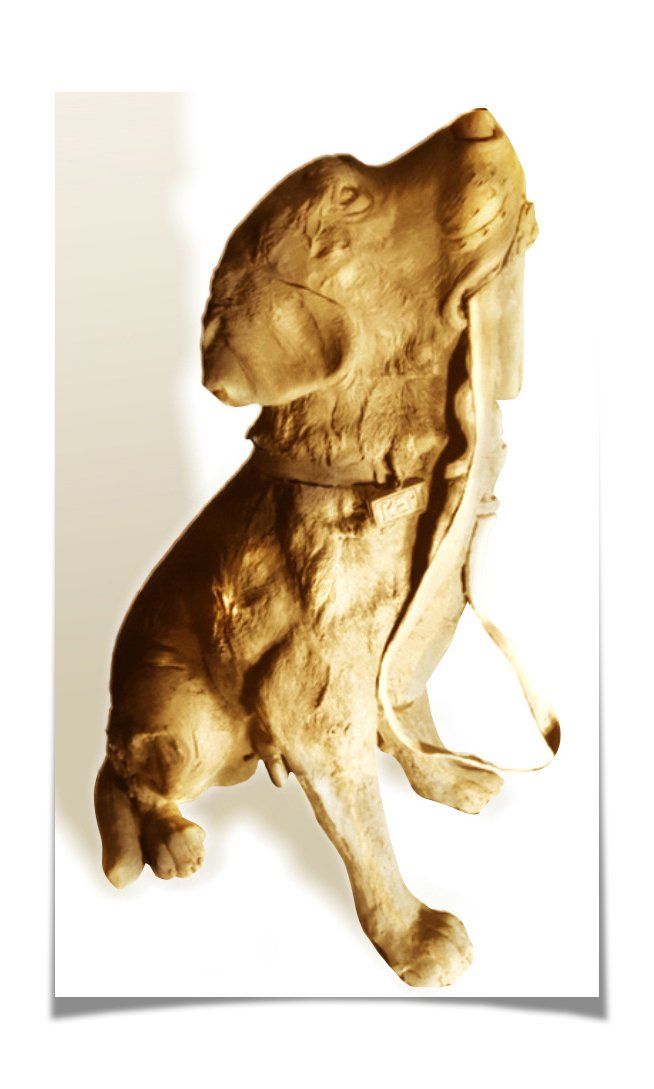
This next bronze statue we have perched atop a cliff-like stone base that we sculpted in the studio, made a mold of, and cast-in-place using 26,000 pounds of grout! Just take a moment and imagine this bronze statue mounted to the top of a square or round architectural stone slab, such as granite. Would that or would that not be a totally different piece, a different art installation?
The concept would not be communicated as clearly. Right? So you see how this base is an integral part of the concept for the sculpture-how it supports the concept, 100%? Coupled with the riffle, ducks, and canteen, this very specifically designed naturalistic rock base says: explorer; taming the West; up against nature; contemplating progress and adventure; the great frontier.
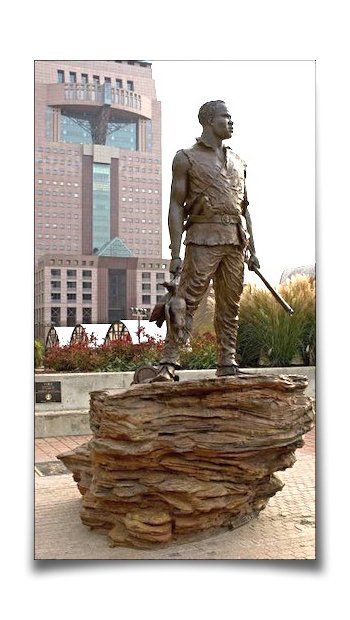
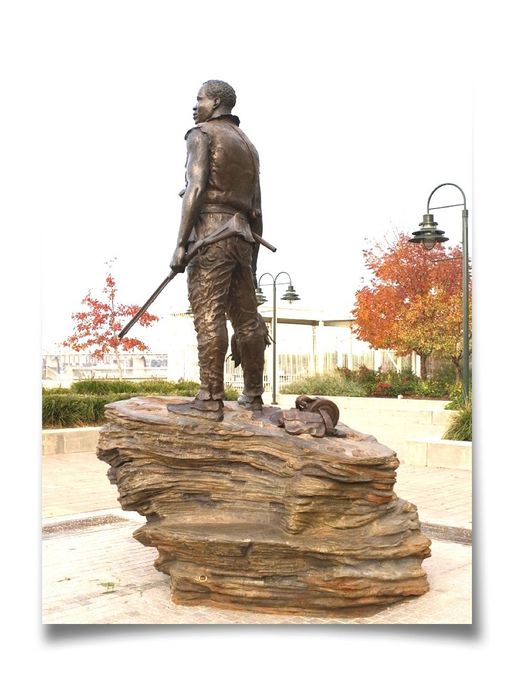
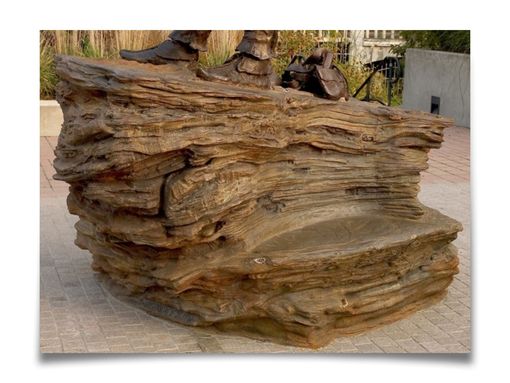
Note that we also incorporated a seating area into the base where visitors can literally sit with the sculpture.
Similarly, in this next bronze sculpture (below) it happens again. And again, you are looking at two sculptures here-the bronze and the sculpted rock pedestal. The base we specifically created for the bronze statue, very much supports the concept of the Wild West. To have put the sculpture on a square stone base with 90 degree corners would not have philosophically supported the concept. Ordinary square stone bases convey order, which was not what we were after. The choice of statue base is a very important part of the decision making process during the design and planning phase.
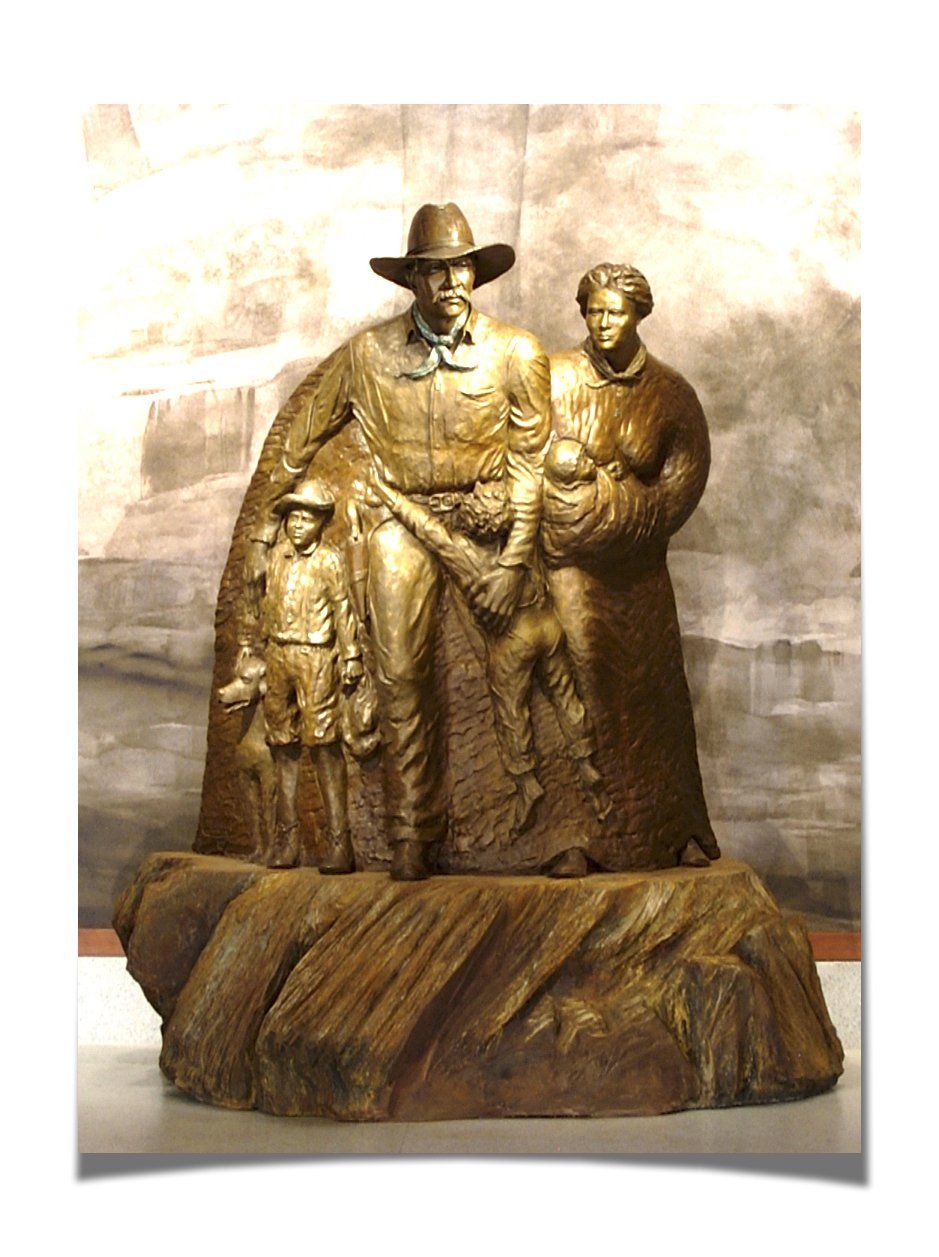
Here are a few more of our animal sculptures. Again, note the high-end, Mercedes-Benz-like quality and dynamic, action-packed gestures that we sculpted into these large scale dog sculptures. Most dog sculptures are static and boring. This bronze, however, is as if the playful moment was frozen in time forever, which was an integral part of the piece. As a memorial, the owner had found memories of his two dogs playing. In fact, we worked from a real photograph of the actual dogs playing, per the client's
s request.
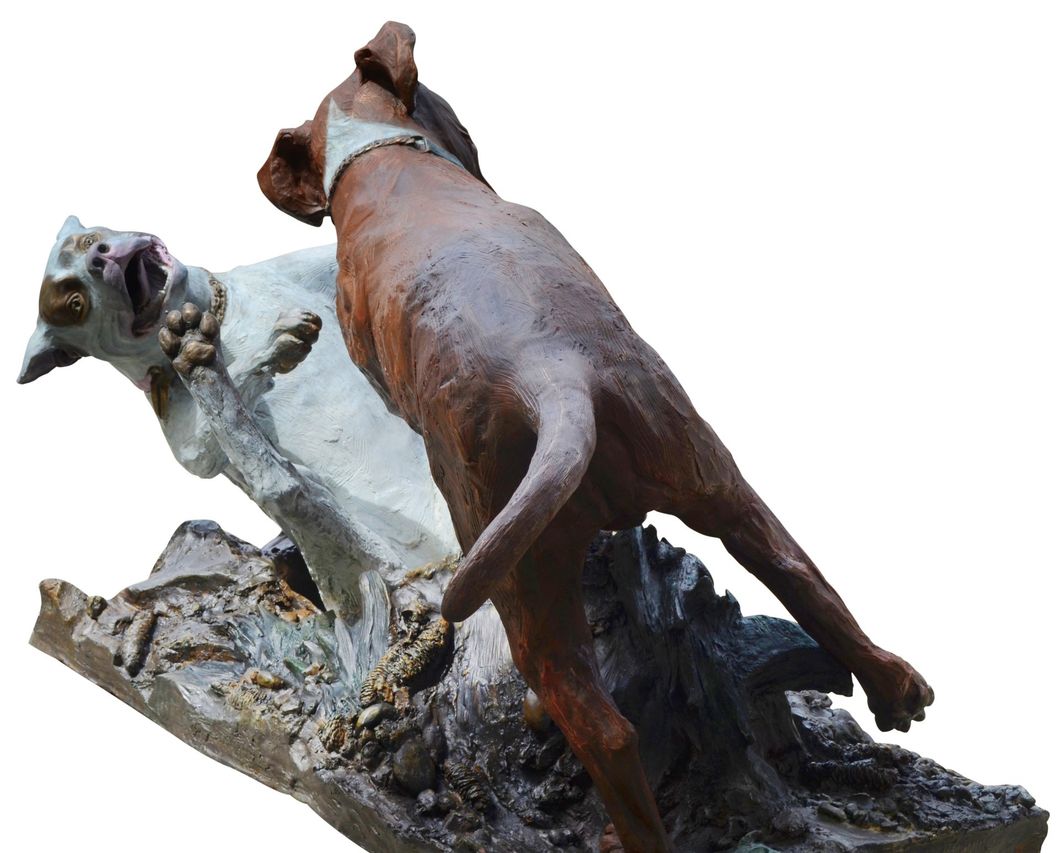
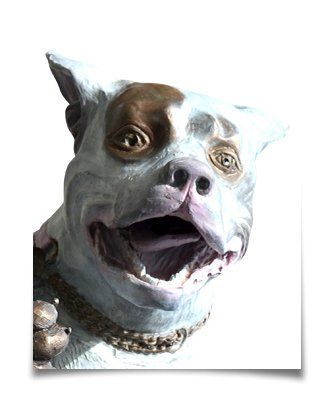

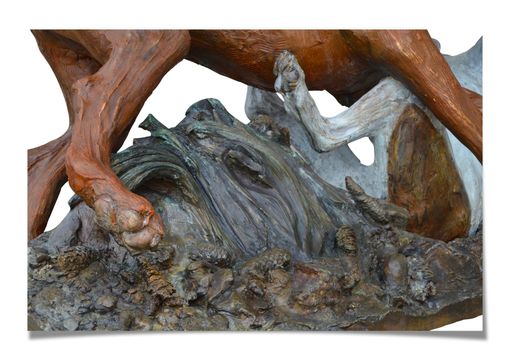

Above is what is called an escarpment, which is basically a small mountain with a dead-end-canyon created by the shifting sections. This one also has a 70,000 pound stone arch bridge that spans the canyon. Our mountainous sculpture, this installation, was commissioned by the widow of Charles Schultz, Joyce Doty, who is the owner of a botanical garden and sculpture park, on the island of Kauai, called Na Aina Kai. This gargantuan sculpture-136 feet long-is part of a Navajo Indian memorial, partly commissioned for visitors who are unable to travel to the mainland and see geologic landscapes like this in person, as found on actual Navajo Indian reservations. This collection of reddish-orange sandstone we simulated, coupled with bronze Navajo Indian and animal statues, sort of "brings the Southwest to the island,," as a site-specific installation. We made the mold in California, then we then transported it overseas to the island, in ten, forty foot shipping containers and casat hundreds of thousands of pounds of grout into the mold. The colored pigment that is required, alone, was over 10,000 pounds!
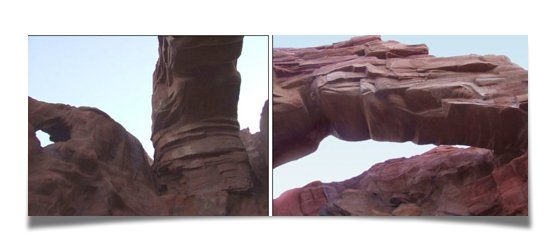
Because the sculpture is so expansive and cannot be rightfully depicted in a single photo, above and below are a number of photos showing different views and different sections of the massive escarpment sculpture, including this hand-detailed cave area and the 17 foot arch that spans the dead-end canyon. We engineered the arch you see here, on articulated joints, to prevent it from breaking apart with any seismic activity over the next couple hundred years!
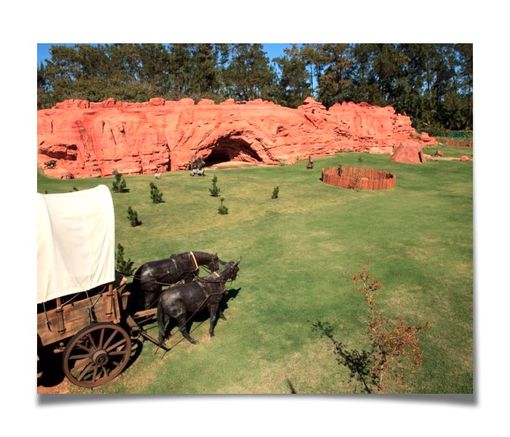
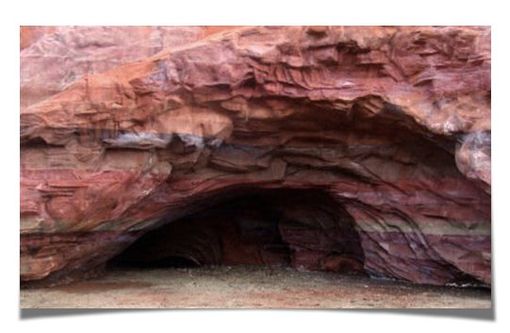
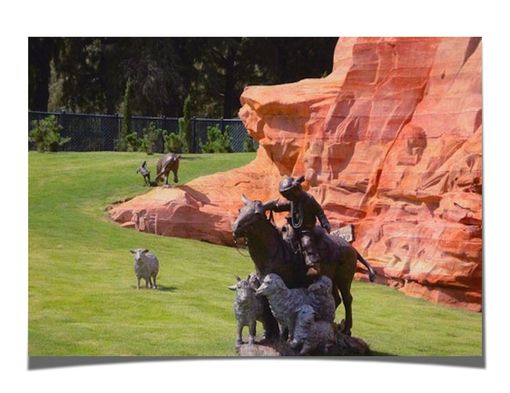
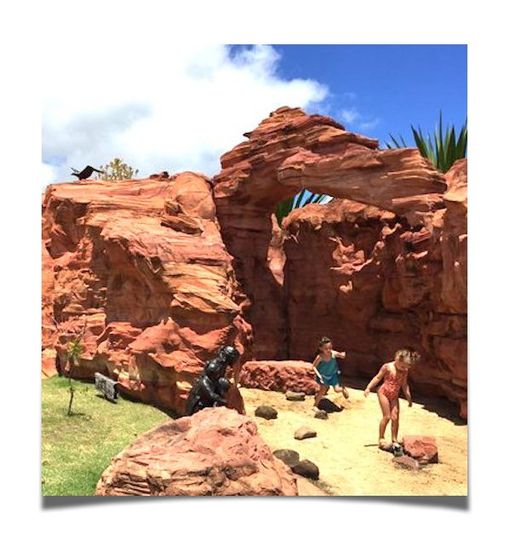
Sculptural Fountains
Forest Boone Studio also sculpts high-end sculptural fountains. Below is an actively flowing fountain that we cast in place in the corporate headquarters of a company called Service Net, (now an AIG sub-company), in Jeffersonville, Indiana. We cast approximately 36,000 pounds of intrinsically colored grout over a matrix of steel, into a 3,000 pound rubber mold by pumping it through a 4 inch hose. First we cast the bottom 5 feet and de-molded that, then we capped it off with two 60 pound, interlocking, cap pieces.
The idea here is very Frank Lloyd Wright. So onlookers experiencing this piece might think to themselves, "the architect and engineers went to great trouble and expense to build this entire building above and around a pre-existing underground cavern system?" That is the real power of this sculpture. Suddenly this high end fountain and it's location has great significance, is very special, perhaps even historic, in the eyes of the viewer, which renders the perceived real estate significantly more valuable.
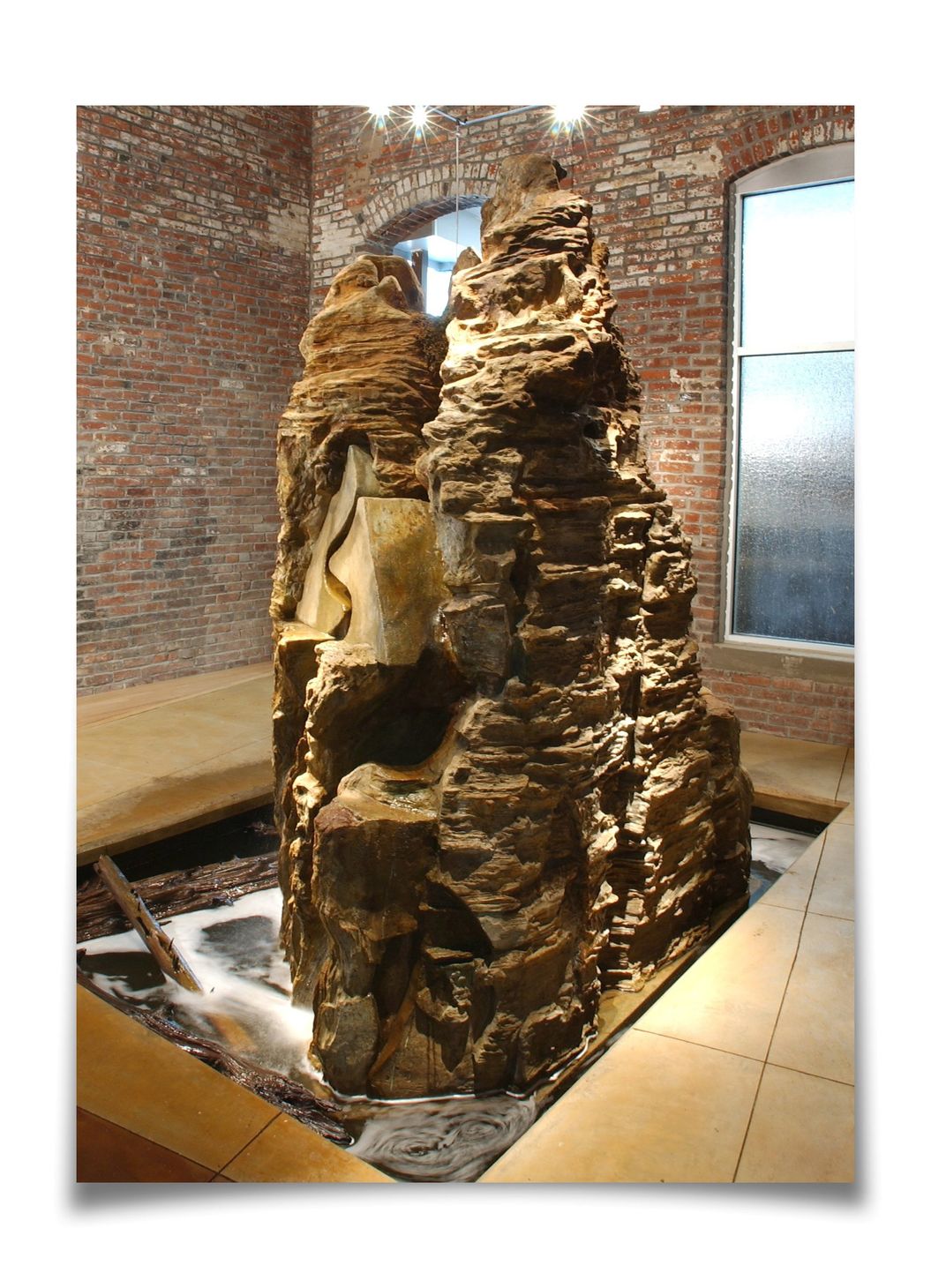
The image below shows water flowing down two of the four eroded trenches, complete with live Eastern Woodland moss, thriving under the lights, and in the mist, for a totally naturalistic effect.
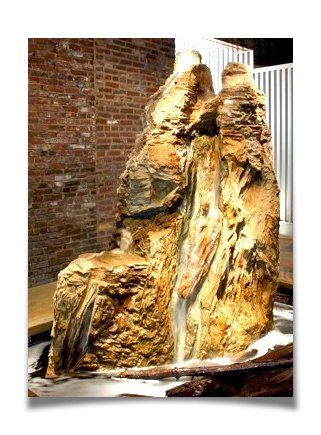
In the image below, note the sophisticated coloration and the vivid detail, only attainable by way of directly casting from nature. Not to boast but you will find no other artificial rock work or rock-and-water features anywhere in the U.S. of this caliber and level of convincingness. Period. The development of this process we used to create what you see here, in fact, led to the birthing of MuseumRock Products, back in 1999, which is a subdivision of Forest Boone Studio.
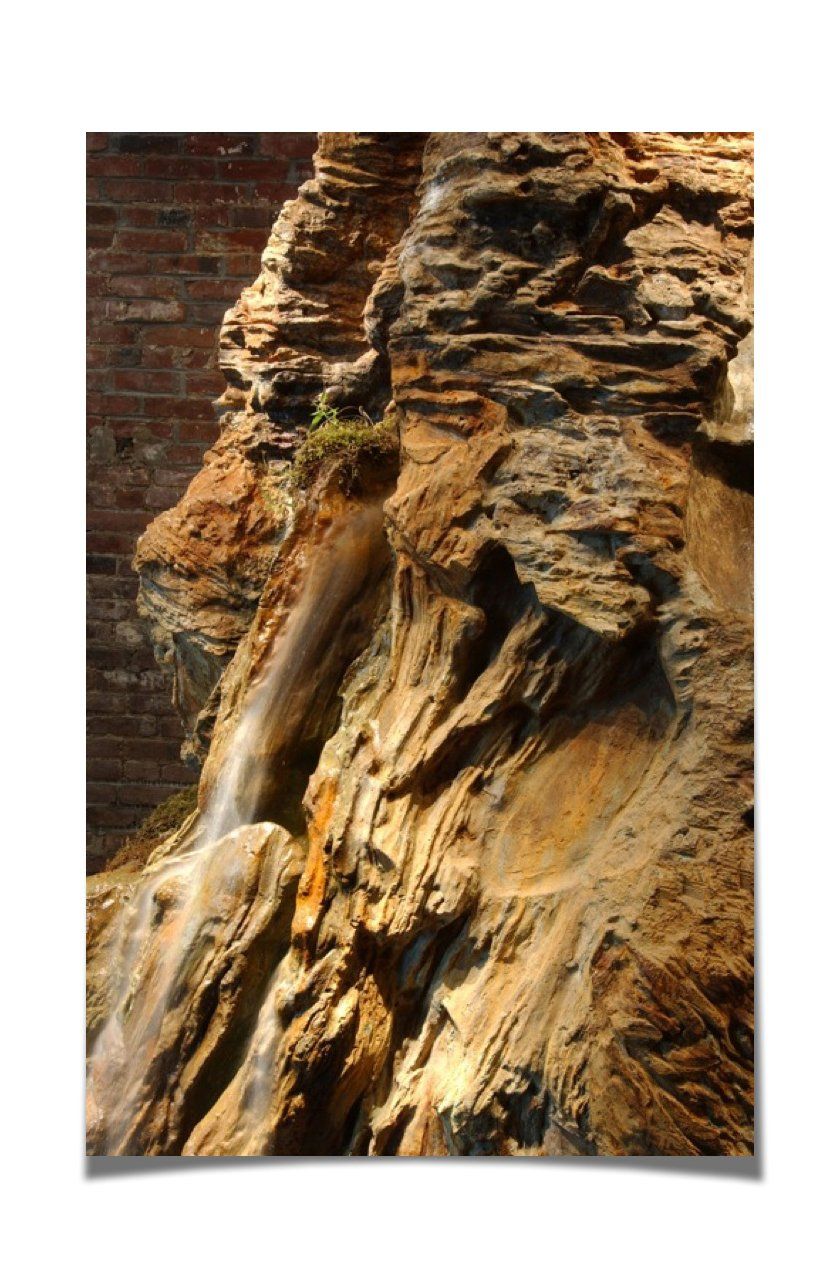
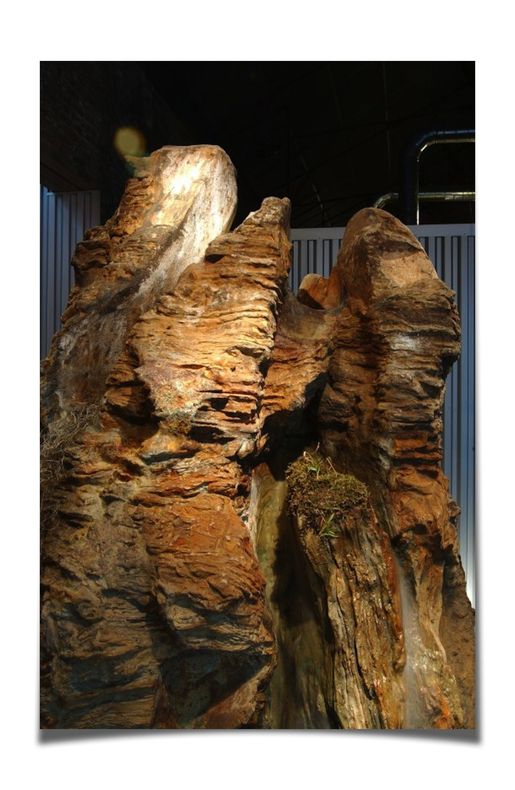
The image to the left shoes how we incorporated the two cap pieces to read as a monolithic geological formation. The illusion of a natural break allowed us to lock the two perfectly in place, and then secure them to the rest with concealed stainless steel rods.
The image below depicts the backside of the fountain. The layering effect demonstrated here shows how our intrinsically colored rock replicates naturally layered sedimentary rock, gritty in texture and cold to-the-touch, just like natural limestone.
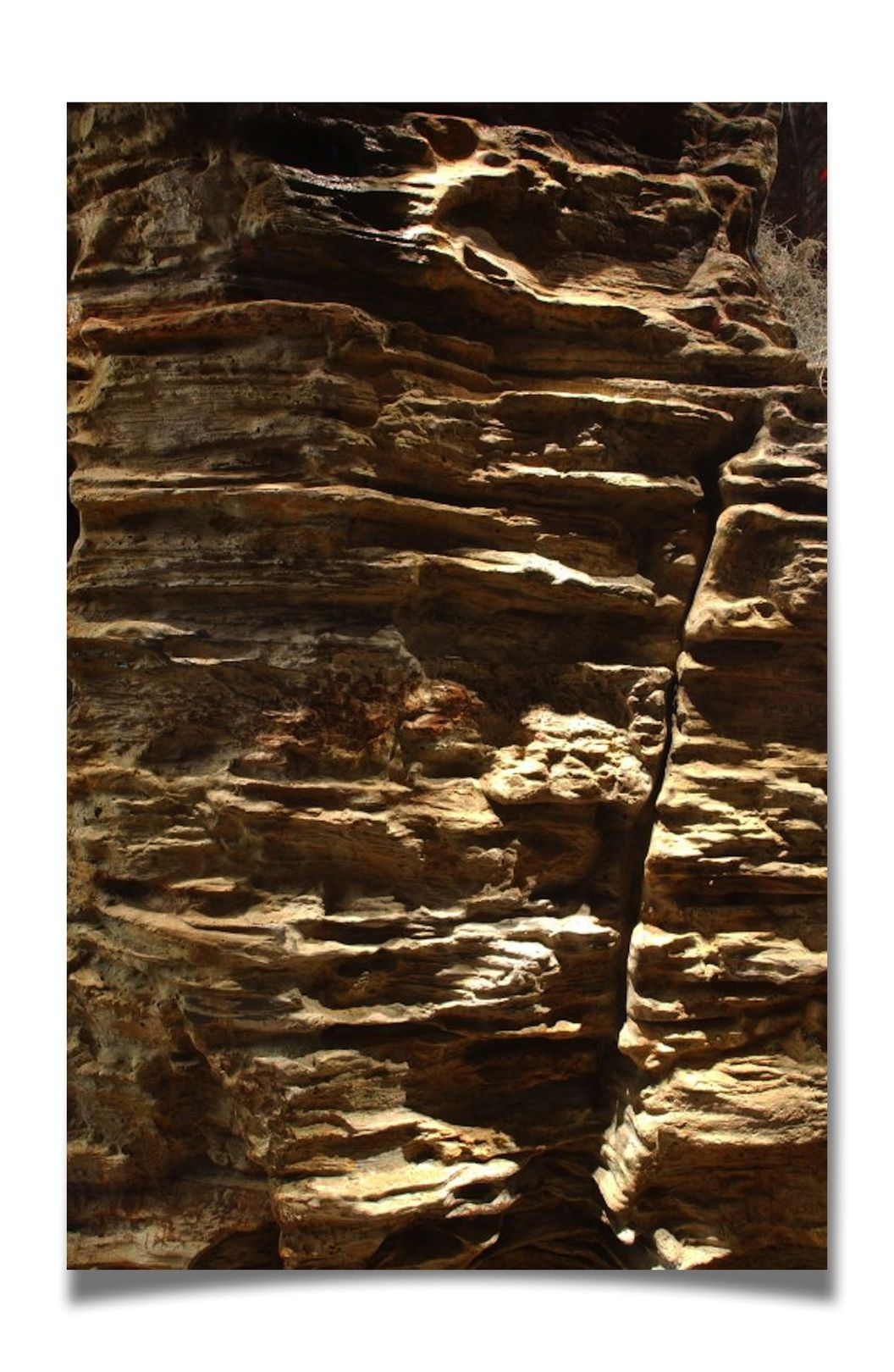
Finally, one more photo of all the details we sculpted into this rock-and-water feature, but from a different angle. Standing in this lobby of the corporate headquarters, employees get a reprieve from their computer screens and are offered a tranquil, synesthetic experience with the sound of the gushing water, the sight of the outcroppings, and the smell of the wet sun-bleached cedar logs and moss. They actually hold company meetings now, in front of this highly naturalistic fountain. Each employee at the meeting makes a wish by tossing a coin into the seemingly bottomless cavern system we created.
(By the way, this sculpture has now been featured in more that half a dozen newspapers and periodicals).

The next image set, below, is of a bronze Native American statue and fountain. He is standing on a MuseumRock boulder, which we cast in place on top of a simulated stream bed, which, in turn, is on top of a 12 foot tall waterfall. The statue's gesture is of him getting a drink from his hand. We simply ran a flexible water line through the hollow bronze and terminated that water line at the palm of his hand. This piece sort of speaks for itself and is a great example of how we can create fountain within fountains.
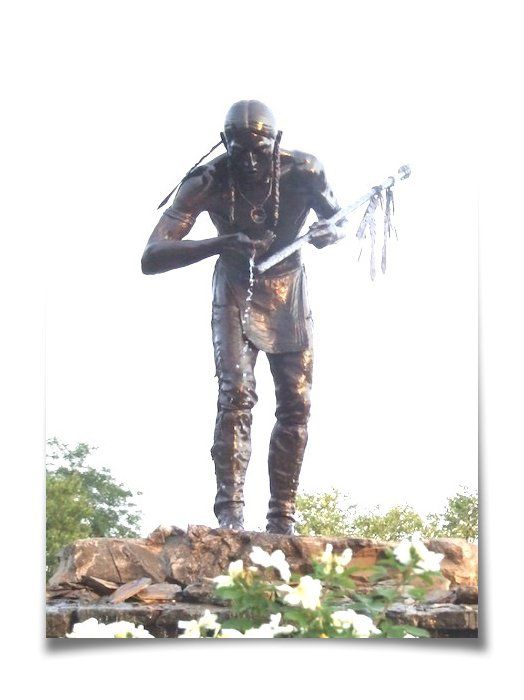
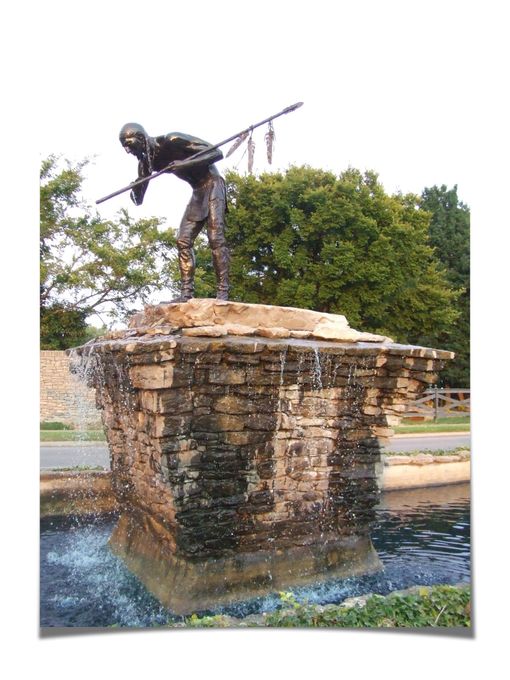
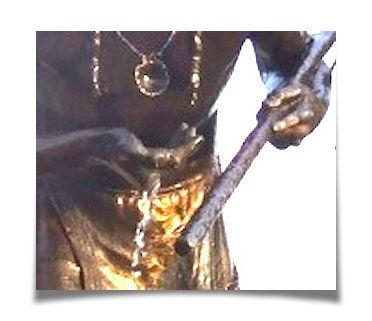
Educational & Interpretive Artwork - Rockscape
Below, the model that we made to 1/10th scale for Taltre Railway Museum, is shown realized, large scale, in all it's glory. It took a little over a year of painstaking attention to the smallest of details for the design challenge, but we designed every stream bed, talus shift, tunnel, rocky slope, cavernous opening, mountain peak, and every waterfall you see here. The full-scale version is chock full of working model trains, functioning outdoors, complete with truss systems, plantings, and actively flowing water sources.
The budget for this outdoor museum installation was well over a million dollars and involved teams of engineers, hydraulics experts, train enthusiasts, contractors, landscape architects horticulturalists, and volunteers, so it was quite an honor for us to have been the ones chosen to design all of the rock-and-water features and hardscapes. The maquette, or scale model, we made took nearly a year. We executed this work in wax (4'x8') through MuseumRock Products, our small sister company.
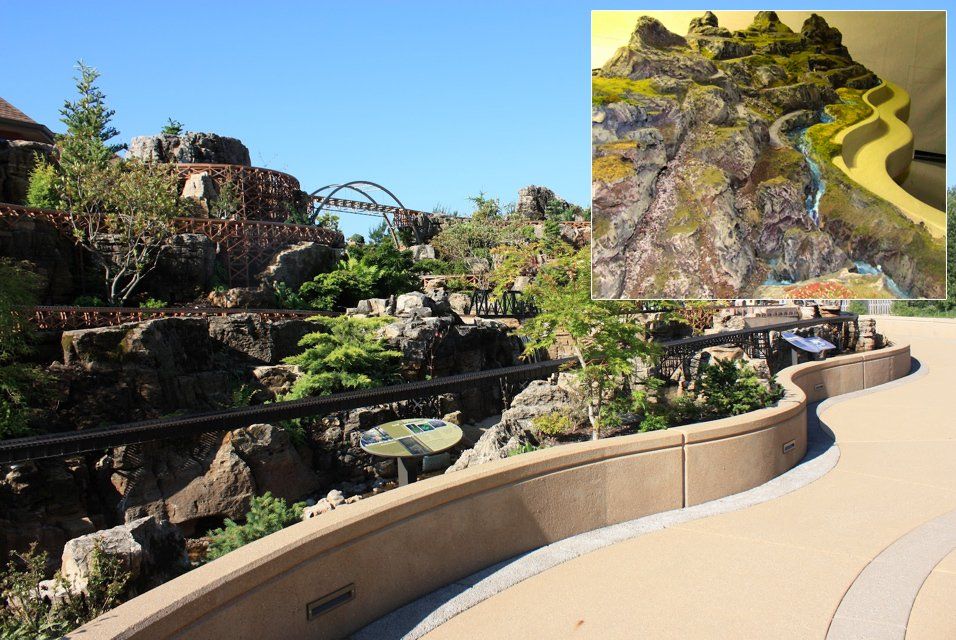
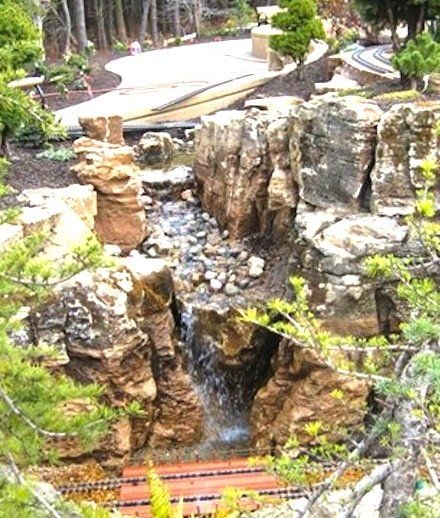
Below, you see a couple of very unique faux rock accent walls we sculpted. The first was for a Kentucky bourbon distillery headquarters, called Bulleit Distilleries. This installation involved water seeping from the wall we fabricated.
That effect was to help educate visitors as to how Kentucky bourbon whiskey is made-with spring water that filters through geologically-formed Kentucky limestone cliff faces.
To the right of our sculpted wet wall image, is a sculpted rock feature we created was for a U.S. Army Transportation Museum in Fort Eustis, Virginia. Both are considered educational and/or interpretive.
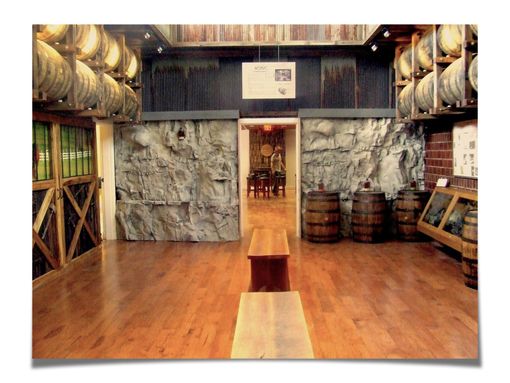
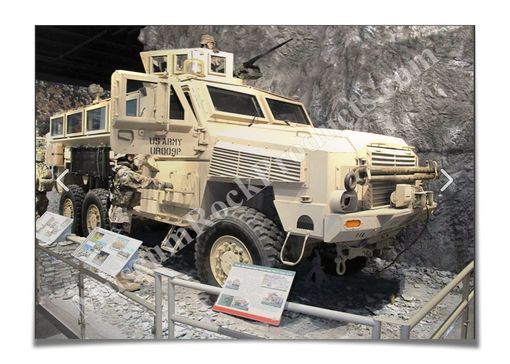
Finally, a larger-than-life bronze and wax sculpture we sculpted for Makers Mark distillery. There is a bronze man stepping off the ladder into the clouds which are inside the huge bottle, which we also cast in bronze.
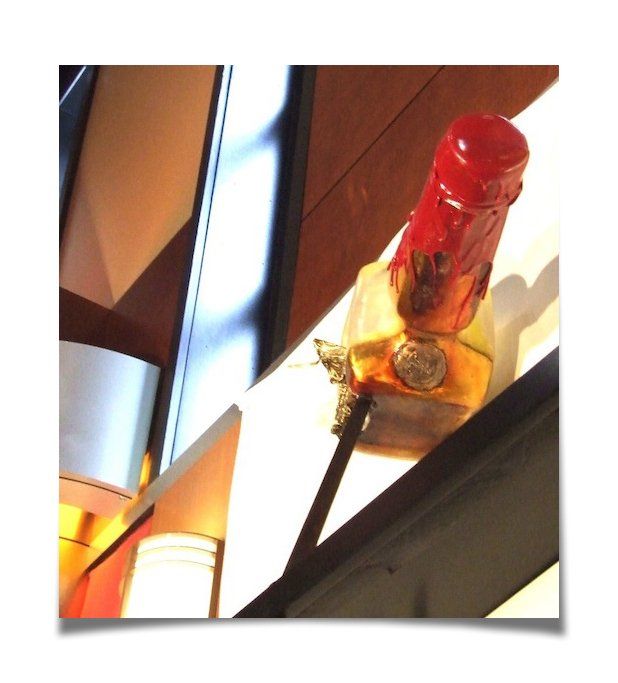
For more of our natural and cast stone sculptures, please head over to MuseumRock.com. There you will also see more waterfalls we created, as well as a series of interior rock training caves that we created for the special operations division of the U.S. military.

